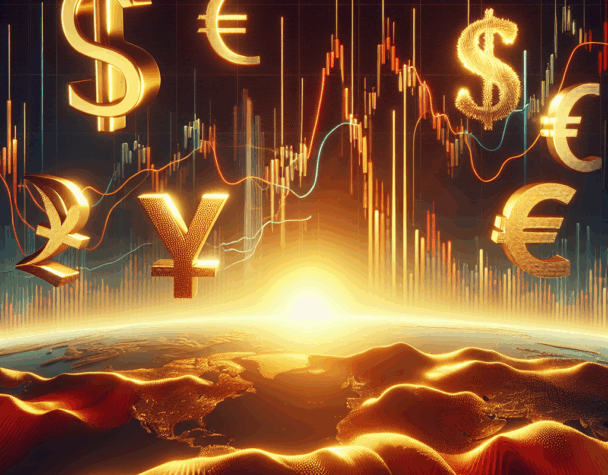
Global Currency Markets React to U.S. Dollar's Decline Amid Trade Policy Shifts
Sat, June 14, 2025U.S. Dollar’s Decline Reshapes Global Currency Markets
The U.S. dollar has experienced a significant decline, reaching its lowest level in three years. This downturn is attributed to shifting U.S. trade policies and mounting expectations for Federal Reserve interest rate cuts, leading to capital outflows. As a result, global currency markets are undergoing notable transformations.
Impact on Major Currencies
Traditional safe-haven currencies have appreciated in response to the dollar’s weakness. The euro, Swiss franc, and Japanese yen have each risen by approximately 10%. However, this rapid appreciation has raised concerns about potential deflation and the need for central bank interventions, particularly in Switzerland and the eurozone. In Asia, currencies such as Taiwan’s dollar and the Korean won have surged around 10-12% as capital flows shift away from U.S. assets. Conversely, China’s yuan has seen only modest gains, drawing attention from U.S. policymakers.
Investor Strategies Amid Currency Volatility
The dollar’s decline has transformed global fund managers into de facto currency traders. Previously shielded from forex risks by a strong dollar and a tech-driven U.S. market surge, investors now face increased currency volatility. Analysts note limited hedging, especially by Eurozone pension funds holding substantial unhedged dollar assets, making portfolios vulnerable to further declines. While U.S. stocks have rebounded in dollar terms since an April tariff shock, European investors have seen declines due to currency conversion. European stocks have outperformed, particularly when calculated in dollars. With currency-specific risk rising—as much as 30% of total risk for euro-based investors—fund managers are grappling with how to safeguard portfolios amid ongoing dollar depreciation.
Debate Over De-Dollarization
Despite heightened concerns about “de-dollarization” during President Trump’s second term, substantial evidence of a global retreat from the U.S. dollar remains lacking. Some major investors anticipate further declines in the dollar’s exchange rate, not due to a collapse in demand for U.S. assets, but as a function of adjusting to temporary market conditions. European Central Bank President Christine Lagarde noted unusual market reactions, including simultaneous drops in the dollar, U.S. Treasuries, and stocks, suggesting nervousness about U.S. economic policy. Contrary to de-dollarization fears, Bank of America strategist Ralph Axel highlights that global “dollarization” has intensified over the past decade. U.S. federal debt quadrupled to $36 trillion, bank deposits doubled since 2008, and shadow banking (NBFI) assets surged to about $63 trillion. These rising liabilities indicate ongoing demand for dollar-denominated assets. However, recent moves by institutional investors, particularly in Europe and Australia, to hedge currency risk may put downward pressure on the dollar.
Central Banks’ Response
An ECB report reveals that the U.S. dollar continued to lose global market share in 2024, dropping 2 percentage points in foreign exchange holdings, now accounting for 58%. However, the euro has not emerged as a clear beneficiary, with its share hovering just below 20%. Instead, currencies like the Japanese yen and Canadian dollar, along with gold, have experienced gains. Central banks increased their gold reserves by over 1,000 tonnes last year—a record pace—driven by diversification and geopolitical risk concerns. Interestingly, gold now accounts for 20% of total global reserves, surpassing the euro’s 16%. Despite ECB President Christine Lagarde advocating for the euro to become the dollar’s alternative, the eurozone’s fragmented debt market, banking system, lack of a unified capital market, and limited geopolitical influence hinder its progress. Recent shifts in April show weakening of the dollar despite rising U.S. yields and increased issuance of euro-denominated bonds, suggesting some potential for the euro. Nonetheless, economists emphasize that without structural integration and the creation of large-scale, safe euro-denominated assets, the euro cannot significantly challenge the dollar’s dominance.
Emerging Market Currencies and Investor Sentiment
A Reuters poll conducted on June 12, 2025, showed a significant rise in bullish positions on most Asian currencies amid ongoing uncertainty surrounding the U.S.-China trade agreement, which put pressure on the U.S. dollar. Notably, the Taiwanese dollar reached its strongest bullish sentiment since December 2020, and the South Korean won marked its highest bullishness in nearly two and a half years. Positive sentiment also increased for the Chinese yuan, which hit its highest level since October. Despite a framework agreement that included tariff adjustments, lifting of Chinese export restrictions on rare earths, and access for Chinese students to U.S. universities, markets were left uncertain due to a lack of implementation specifics. The dollar index has already fallen over 9% this year and is projected to decline further. South Korea’s currency strengthened following the election of President Lee Jae-myung, backed by promises of economic stimulus. Taiwan’s dollar has gained 10% this year, partly fueled by speculative trade benefits with the U.S. Conversely, sentiment weakened slightly for the Singapore dollar and Philippine peso, while views on the Indian rupee turned mildly bearish after an unexpected central bank rate cut. The poll reflects market positioning across nine major Asian currencies.
Conclusion
The rapid decline of the U.S. dollar is reshaping global currency markets, influencing central bank strategies, and prompting investors to reassess their portfolios. While some currencies benefit from the dollar’s weakness, the overall landscape remains complex, with ongoing debates about de-dollarization and the future of global reserve currencies. Investors and policymakers alike must navigate this evolving environment with caution and strategic foresight.
For more detailed insights, refer to the following articles:
- The dollar’s crown is slipping, and fast
- Dollar weakness is turning all fund managers into currency traders
- Watch out for dollar FX fall more than ‘de-dollarization’
- Dollar keeps losing market share but euro is no winner either: ECB study
- Bulls load up on Asian currencies as trade uncertainty knocks dollar: Reuters poll

